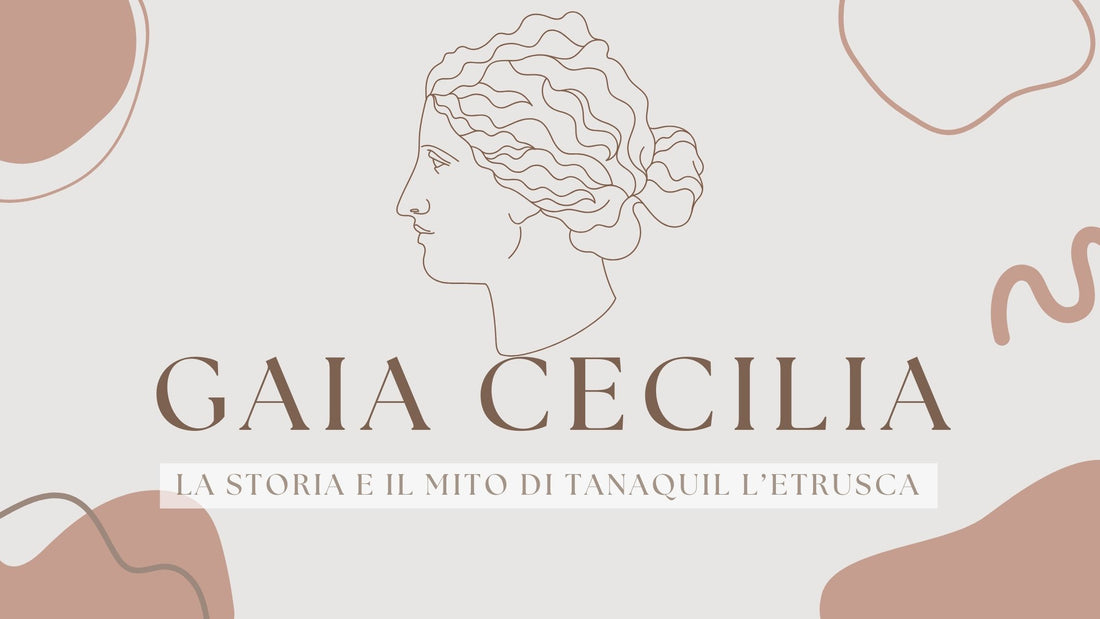
Gaia Cecilia, the history and myth of Tanaquil the Etruscan
share
The Priestess

Tanaquil (also known as Tanaquilla) was born in Tarquinia towards the middle of the 7th century BC into a noble family of high lineage. Probably of priestly class, endowed with a bursting personality, cultured, free, emancipated and able to play a role in society, This noblewoman from Tarquinia, prototype of the Etruscan woman , played a decisive role in the history of early Rome.
She married Lucumone , son of Demaratus, a noble and rich citizen of Corinth, (the presence of Corinthians was not unusual in Etruria) from where he had been expelled for political reasons. Having taken refuge in Tarquinia, he had seen his wealth increase. Lucumone was a wise man. and generous, courageous and skilled leader. Despite everything, however, Etruscan tradition did not allow a foreigner to aspire to the highest public offices.
Tanaquil therefore, seeing that her husband was not considered in Tarquinia and indeed marginalized because he was Greek, encouraged him to leave Tarquinia to emigrate to Rome, the metropolis where every race and origin was accepted, the enlightened and civilized city: Rome, the Caput Mundi.
It is she, therefore, and not her husband, who decides and organizes the transfer to Rome; it is she, proud and fearless, who wants to face a destiny that would change history. They go down the coast to the mouth of the Tiber and go back up to the Janiculum. Here destiny expresses itself on the future of Lucumone; in fact, upon their arrival in Rome, an eagle first steals her husband's cap and then comes back and lets it fall back on his head. The husband is frightened, considering it an inauspicious sign, but Tanaquil, who knew how to interpret omens, sees in this the favor of the Gods and a glorious future for her husband.
She thus changes her name to the "more Latin" Gaia Cecilia (also Gaia Cyrilla, Caia Caecilia or Caia Cyrilla) and begins to frequent the high society of Rome, inserting herself and her husband into the social and political life of the city.
The Queen

With his help, Lucumune had a brilliant career until his election as king, with the name of Lucius Tarquinius, later called Priscus , to distinguish him from the last king of Rome, Tarquinius Superbus.
Many believe that Tanaquil continued to influence her husband's decisions in the following years. What is certain is that during the reign of Tarquinius Priscus, from 616 to 579 BC, Rome changes radically . Upon their arrival, the two spouses find only small villages on the Roman hills and a vast marshy area in the flat areas. Tarquin has it drained, transforming the dried up land into a market place. During his reign, he also begins the construction of the Cloaca Maxima, the oldest sewer system in Rome. From the center of the city, he then starts a network of paved streets, including the Via Sacra. He also lays the foundations of the temple of Capitoline Jupiter; he expands the class of knights and centuries; he erects the Circus Maximus where citizens attended the first horse races; he established the Roman Games, one of the most important festivities in the Roman calendar. Finally, he gave a notable boost to the arts.
Tarquinius Priscus always lets himself be guided and advised by Tanaquil, whose gifts of wisdom and foresight he knows.
The myth and the legend
Meanwhile, the eldest son of Ancus Marcius, predecessor of Tarquinius Priscus, in the hope of obtaining the throne that he believed had been usurped from him, organizes a plot. Two shepherds, pretending to want to speak to the king, manage to mortally wound him with blows from an axe. The sixty-year-old Gaia Cecilia takes control of the situation, demonstrating unthinkable nerve and coolness.
She had her dying husband carried into the house and, to hide what was happening, she closed the doors of her house and sent the curious away.
Torn in her heart but smiling on her face, from the top of the building that stands near the temple of Jupiter Stator and has windows overlooking the Via Nuova, she harangues the crowd that has gathered, convincing them that her husband had escaped the attack but needed long-term care.
The queen, in fact, had already designated the new king Servius Tullius , husband of her daughter, who was the first to reign, as Livy writes, «iniussu populi voluntate patrum» or not by the will of the people. The elderly Etruscan noblewoman makes a frank, demanding, courageous speech against the conspirators and even more against the succession of her own sons, Arunte and Lucio: « tuum est, Servi, si vir es, regnum, non eorum qui alienis manibus pessimum facinus fecere ...».
Thus he had Servius Tullius accepted first as regent, appointed by Tarquin himself, pending the king's recovery, and when he later announced that the king was dead (long after he actually was), Servius, who was also Etruscan, had already been accepted by the people as the sixth king of Rome.
It is incredible how a « peregrina mulier, tantum moliri potuisset ut duo continua regna viro ac deinceps genero dedisset », that is, that a foreign woman was able to scheme so much as to procure two kingdoms, one after the other, first for her husband, then for her son-in-law. A foreign woman, devoted to her husband, ambitious for herself but also for him. An Etruscan woman with a bit of a clairvoyance, whose relics, according to Pliny, were venerated as objects of worship. In particular, the distaff, preserved in the temple of Sanco, on the Quirinal, and the cloak she herself wove for Servius Tullius, preserved in the temple of the goddess Fortuna.
Where you are Gaius, Gaia I am
The Romans worshiped Gaia as a Goddess . They honored Gaia/Tanaquil for her domestic skills, as the Mother Goddess had taught women to weave and spin, also inventing the spindle and the loom.
Goddess of Fire and Women, in the wedding ceremony, as part of the ritual, the bride said: Ubi tu Gaius, Gaia ego , which means "Where you are Gaius, I am Gaia", as if to say ''wherever you are/will be, my place is/will be next to you''.
A very powerful woman or a figure more legendary than historical , Tanaquil the Etruscan remains a character so mysterious and so important that even today she continues to exert an undeniable influence and charm.
Our latest wine, GAIA CECILIA , is dedicated to her. It is produced from 100% Violone grapes, native to Alta Tuscia Viterbese.

Its logo, the circle , used since ancient times by astronomers to indicate the planet Venus, represents femininity in a broad sense (the circle is a representation of the mirror of the Greek goddess of love, beauty and fertility).
The circle also recalls the infinite cycle of the day. Venus was seen by the Sumerians as the morning and evening star: it was the first star to appear at sunrise and the last to remain visible at sunset.
Furthermore, it has always fascinated our sight since we were children, when we threw a pebble into the sea or the lake to observe circles widening and expanding in the water, all arising from that center caused by us. As the circles are increasingly larger as we move away from the center, so too the mother's womb expands month after month in anticipation of a child. The feminine is connected to this: from one to many circles of different sizes, continuous because from one another opens, one inside the other. It symbolizes an energy that expands and increases progressively, that takes strength from the inner center.
Interestingly, the symbol of Venus is also an alchemical symbol representing copper, the material used to forge mirrors in ancient Greece. This is why the color of the label recalls bronze-copper.
